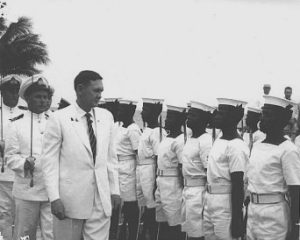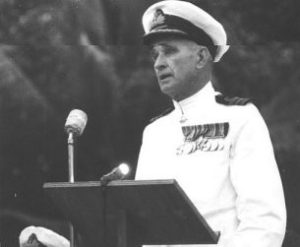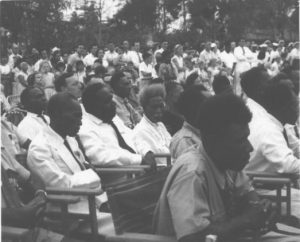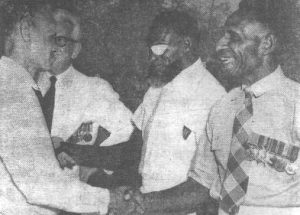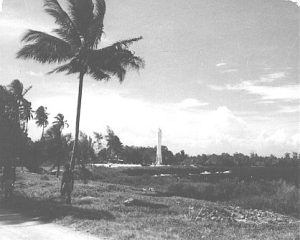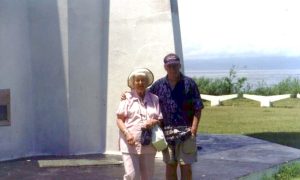The unveiling of the Coastwatchers Memorial Lighthouse at Madang on 15 August 1959: Roma Bates
(first published in the September 1999 issue of the PNGAA Journal, Una Voce, and reformatted for the PNGAA website in January 2015)
Forty years ago, the Coastwatchers Memorial Lighthouse, at the entrance to Madang Harbour, was dedicated and switched on for the first time. Present at that ceremony was Roma Bates who, after the dedication, wrote two letters to friends and family. The following is a composite of those two letters.
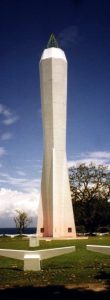 Many of you will know the persons mentioned, either by repute or from personal friendship or acquaintance. Regrettably, many of them are no longer with us, however for those Una Voce readers who may be interested, “Elma” was the widow of Percy Good who was executed by the Japanese at Kessa plantation following an indiscreet Australian news broadcast which mentioned a Japanese convoy that had been sighted off Carola Haven near Kessa several days earlier. This event caused the military authorities to formally appoint all existing, and future, civilian Coastwatchers to naval rank. “Edna” was the wife of F. Ashton (Snowy) Rhoades (DSC [US]; Silver Star) of Guadalcanal fame. “Eric Feldt” (OBE), was Commander of the Coast Watchers in New Guinea, Papua and the Solomon Islands from 1939 to 1945. He was the author of The Coast Watchers (Re-published by Penguin Books Australia Ltd 1991). “Walter Brooksbank” was Assistant to the Director of Naval Intelligence, based in Melbourne. “G.W.L. Townsend” (OBE) was the first head of ANGAU. “Alan Roberts” (MC), a Coastwatcher on New Britain, became the Director of District Services & Native Affairs shortly after the war. “Golpak” (MBE) Paramount Luluai – responsible for the rescue of many Australian soldiers and had been tortured by the Japanese. “Yawita” [Yauwika](Loyal Natives’ Medal) – Sergeant New Guinea Police – accompanied Coastwatcher patrols New Britain and Bougainville. “Roma Bates” (a long time member of the Association – Patricia, Hilary and David are her children) is the widow of C.D. Bates, MC, a Coastwatcher on New Britain who at the time of his death in 1954 was District Commissioner, Madang.
Many of you will know the persons mentioned, either by repute or from personal friendship or acquaintance. Regrettably, many of them are no longer with us, however for those Una Voce readers who may be interested, “Elma” was the widow of Percy Good who was executed by the Japanese at Kessa plantation following an indiscreet Australian news broadcast which mentioned a Japanese convoy that had been sighted off Carola Haven near Kessa several days earlier. This event caused the military authorities to formally appoint all existing, and future, civilian Coastwatchers to naval rank. “Edna” was the wife of F. Ashton (Snowy) Rhoades (DSC [US]; Silver Star) of Guadalcanal fame. “Eric Feldt” (OBE), was Commander of the Coast Watchers in New Guinea, Papua and the Solomon Islands from 1939 to 1945. He was the author of The Coast Watchers (Re-published by Penguin Books Australia Ltd 1991). “Walter Brooksbank” was Assistant to the Director of Naval Intelligence, based in Melbourne. “G.W.L. Townsend” (OBE) was the first head of ANGAU. “Alan Roberts” (MC), a Coastwatcher on New Britain, became the Director of District Services & Native Affairs shortly after the war. “Golpak” (MBE) Paramount Luluai – responsible for the rescue of many Australian soldiers and had been tortured by the Japanese. “Yawita” [Yauwika](Loyal Natives’ Medal) – Sergeant New Guinea Police – accompanied Coastwatcher patrols New Britain and Bougainville. “Roma Bates” (a long time member of the Association – Patricia, Hilary and David are her children) is the widow of C.D. Bates, MC, a Coastwatcher on New Britain who at the time of his death in 1954 was District Commissioner, Madang.
Madang will never again have a weekend as wonderful as the one just past. A weekend of pomp and solemn ceremony, of homage and remembrance to those no longer with us, of joyous reunion and festivity. The atmosphere was overwhelming and one was caught up in it and swept along with the tide. For months and months we have watched the progress of this Lighthouse with great interest, admiring its graceful white line which gives the impression of swirling upwards to the light itself, and on Saturday we saw the culmination in the impressive unveiling ceremony which commenced at 5 p.m.
Every effort had been made by the Navy and Air Force to bring Coastwatchers, widows and relatives from every part of Australia and New Guinea to be present at this ceremony – never again, in the history of New Guinea, will there be so many of them gathered together. It was the book “The Coastwatchers” come to life – with a few sad omissions.
From Thursday on, planes arrived bringing interested spectators as well as the above and everywhere in Madang one would see friends reminiscing and discussing old friends and their whereabouts. Edna Rhoades arrived Friday, Ashton being already here for the occasion. Late afternoon (Friday) there was a reception aboard HMAS “SWAN” (in port for the occasion) for Coastwatchers and relatives. Most of them I hadn’t seen for 13 years or more and although they all knew me, I was hard put to recognise the slim young men I remember them as, in the older and greyer edition before me. All the big brass of Allied Intelligence Bureau were there also and dear old Commander Brooksbank seemed to be as delighted to see me as I was to see him. It was a very happy evening indeed. When we got home, Roy and Elizabeth [Sowerby] and their guest Alan Roberts came over to spend the evening with us and Ashton and Alan regaled us with stories of their coastwatching activities. A wonderful time was had by all. We staggered to bed in the early a.m. Saturday, Elma Good arrived (direct from Kessa – the Governor-General had lent his plane for the RAAF to fly widows and relatives from all over to Madang for the ceremony). On the way home we called in to the hotel to check on arrangements for the ceremony and it was there we met again more Coastwatchers who had arrived in the meantime. I wish I could convey to you the excitement and feeling in the air. They were gathered there en masse and everyone made a great fuss over everyone else. We hurried home to make the wreaths. The atmosphere was terrific and it was so heart-warming and wonderful.
Throughout Saturday the roads were thronged with natives heading towards the Lighthouse and by afternoon all the enclosures were packed, every tree dripped with spectators. Also in Madang for the occasion were representatives of the United States Navy, the Director of Lighthouses (Mr. Gordon Laycock), Minister for the Navy (Senator Gorton), besides representatives of Army, Navy and Air Force; the Allied Intelligence Bureau became the official channel for activities.
The Memorial is, without question, the most beautiful and magnificent design to commemorate the work these men did. As they watched the coast, so now does their memorial. The design was surely inspired. Its simple classic lines sweep from a four-finned base to a fuller top surmounted by a bronze guard in the shape of a flame (narrow strips of bronze which outline the shape of a candle flame) and within this guard swings a 1,000,000 candlepower searchlight.
The construction is of dazzling white cement. The lighthouse, 90 feet high, stands on a base of red terrazzo tiles, and on this circle, between each set of fins, is a bronze plaque. The plaque between the two front fins is the Honour Plaque with the names of the fallen, on the left side is a plaque which reads:
“In honour and grateful memory of the Coastwatchers and of the loyal natives who assisted them in their heroic service behind enemy lines during the Second World War in providing intelligence vital to the conduct of Allied operations. Not only did they transmit by means of teleradio from their jungle hideouts information which led to the sinking of numerous enemy warships, but they were able to give timely warning of impending enemy air attacks. The contribution towards the Allied victory in the Pacific by the small body of men who constituted the Coastwatchers was out of all proportion to their numbers.”
The space between the fins at the back has no plaque as it serves as the entrance to the ladder that goes up inside the light. The remaining space is occupied by a plaque containing the above inscription in Pidgin English for the benefit of the native community.
The Light standing on its red circle is set in the centre of a huge cross, the wide arms of which serve as footpaths; this in turn, is surrounded by a large enclosure of crushed coral fenced with 3 foot high pyramids of white cement suitably spaced and connected with black chains. The Light is situated on the Point at the entrance to Madang Harbour – where the old light used to be.
Originally, the design was supposed to represent a torch, similar to a Legacy torch, but it was necessary to add the four fins at the base for strength and to carry the weight, so that now, it looks like a finned bomb with the warhead sliced off. A truly magnificent sight, with the revolving searchlight taking the place of the bomb warhead. This Light can be seen by any small ship 15 miles out to sea and by aircraft 50 miles away. This Light is a memorial to the work of all the Coastwatchers but only the names of the 36 men who died during operations are inscribed on the Honour Plaque.
THE FALLEN COAST-WATCHERS
GUY ALLEN
F.A. BARRETT, LIEUTENANT, A.I.F.
D.N. BEDKOBER, LIEUTENANT, A.I.F.
L.J. BELL, LIEUTENANT, R.A.N.V.R.
C.E. BENGOUGH, CAPTAIN, B.S.I.D.F.
G.M. BENHAM, SUB-LIEUT., D.S.C., R.A.N.V.R.
J.I. BUNNING, GUNNER, A.I.F.
W.A.H. BUTTERIS, SERGEANT, A.I.F.
L.T.W. CARLSON, SERGEANT, A.I.F.
J. DAYMOND
T.J. DOUGLAS, WRITER, R.A.N.
T. EBERY
W.F.B. FLORANCE, SERGEANT, A.I.F.
A.E. FRANCIS, SIGNALLER, R.A.N.
P.D. GOOD
G.C. HARRIS, CAPTAIN, A.I.F.
C.C. JERVIS
LEONARD KENTISH
G.T. KNIGHT, YEOMAN OF SIGNALS, R.A.N.
A.F. KYLE, LIEUTENANT, D.S.C., R.A.N.V.R.
S. LAMONT, CHIEF YEOMAN OF SIGS., R.A.N.
D.A. LAWS, LIEUTENANT, A.I.F.
C.J.T. MASON, FLYING OFFICER, R.A.A.F.
N.B. MARTIN, SERGEANT, A.I.F.
E.F.H. MITCHELL, SUB-LIEUTENANT, R.A.N.V.R.
A. OBST, WARRANT OFFICER II, A.I.F.
A.R. OLANDER, SUB-LIEUTENANT, R.A.N.V.R.
C.L. PAGE, SUB-LIEUTENANT, R.A.N.V.R.
L. PURSEHOUSE, CAPTAIN, A.I.F.
G. SHORTIS, TROOPER, A.I.F.
G. STEVENSON, LIEUTENANT, A.I.F.
J. TALMAGE
G.H.C. TRAIN, LIEUTENANT, R.A.N.V.R.
W. TUPLING, PETTY OFFICER, R.A.N.
L.G. VIAL, FLIGHT-LIEUTENANT, R.A.A.F.
J.L. WOODROFFE, LEADING TELEGRAPHIST, R.A.N.
“They waited and warned and died that we might live”
On the left side is the following plaque:
The ceremony commenced with the posting of three sentries at the base of the Light – a member of the Volunteer Rifles (Bruce Collins), a rating from the Swan and the Air Force was the third. This was followed by Guards of Honour of European and Native Naval ratings, New Guinea Volunteer Rifles and Royal Papua and New Guinea Constabulary taking up position. The two enclosures with seats, one for the Coastwatchers and the other for relatives, were situated on one side of the path leading to the Light and opposite was the dais on which were all the V.I.P.s previously mentioned together with local dignitaries of Church and State. Elma Good and Edna Rhoades were staying with me and we took our seats in good time. It was touching to see the warm welcome and comradeship extended to the Native Coastwatchers by their European counterparts as they arrived one by one to take up their places in the enclosure.
A bugle call announced the arrival of the Minister for the Navy who inspected the Guards of Honour before taking his place on the dais. Then followed speeches by Australian and U.S. Navy representatives, and various other dignitaries. All spoke beautifully but the speech made by the Director of Lighthouses, Mr Laycock, I considered the most moving and impressive of them all (I have since learnt that he is a poet). I appreciated it the more as he was not a Coastwatcher. When it was decided to have a lighthouse as a memorial, the committee or rather Commander Brooksbank, went to interview him about it, and so caught up with the enthusiasm for such a wonderful idea was he that he also went on the committee, and after reading about the Coastwatchers and their brave work, wrote a poem about them, the last
of which is on one of the plaques : “They watched, they warned, they died, that we might live”. I would very much like a copy of his speech to keep. Eric Feldt who was visibly very moved, spoke briefly and unveiled the Honour Plaque. After the unveiling, wreaths were laid by V.I.P.’s, followed by private ones (Elma, Edna, David – who was wearing his father’s medals – and I placed wreaths too).
By this time it was dusk and therefore when the switch was thrown by the Minister for the Navy for the first time, the Memorial showed to best advantage. I have previously omitted mention of the floodlights on purpose to give this description of the ceremony the final dramatic touch. The Light and the floodlights flashed on together and the effect was breathtaking; we all had lumps in our throats. The floodlights are a permanent feature. They illuminate for 1/2 minute every three minutes and are so placed that although the column is brightly lit, there are two shadows which cut across it from left base to right top; this greatly enhances the overall effect and seems to make the column look even taller.
This was the official end of a solemn and very beautiful ceremony.
Everyone gathered around the Light to read the plaques and on all sides friends were greeting friends they had not previously caught up with, particularly so between Native and European. Faces lit with joy at seeing each other again. Here, for the first time, I saw exemplified what we are striving for throughout Papua and New Guinea – the mutual respect, admiration and real affection between European and Native. It filled me with hope for the future and showed that, even without the benefit of higher education, the Native and European can go forward together with mutual confidence. The happiness of comrade greeting comrade was wonderful to see and their joy was mine also when the Native Coastwatchers, unsolicited and unprompted, found me in the dusk. Shaking my hand warmly and long, they spoke glowingly and feelingly of your father and we were all very emotional. They told David about his father and I hope it is something David will always remember with pride. I had tears in my eyes and so did they, clearing of throats and so on, but one made me laugh although I was so emotional when he asked me point blank – or rather, said “I suppose you have another husband now.” I didn’t know any of them nor did their names ring a bell. Bless their hearts. One of them is now a police-boi stationed in Madang, transferred here a few months ago. He told me he had been looking for me on several occasions before but was told I was away on leave so was glad he had caught up with me at last. He assured me of his best attention and protection should I ever need it.
Saturday night there was a dinner at the hotel for all the Coastwatchers (men only of course) and the women were invited to go up later. At the same time as this dinner was taking place, the Native Coastwatchers had a dinner at the Native Club at Tusbab. Later in the evening Commander Townsend, the Administrator and Alan Roberts visited the Club to make a presentation to Golpak’s son. You remember Golpak, the Paramount Luluai down Jacquinot Bay way, don’t you? He saved the lives of over 100 airmen and, intensely loyal and even under threat of torture, would not give away their whereabouts. In the end it got so hot that his son was evacuated by the Coastwatchers for safety. He was a wonderful old man. Hilary was present at the ceremony in Rabaul years ago when Golpak was decorated. Anyway, Townsend had Golpak made a Member of the Royal Airforce Escape Society but he died a short time ago just before he could be presented with it. So Golpak’s son was brought to Madang this weekend and on Saturday night, at the club, Townsend gave the assembled company a resume of Golpak’s war effort and presented his son with the Certificate of Membership of the Royal Air Force Escape Society. A very high honour indeed; Golpak was with your father at one stage.
Another Coastwatcher who was made a great fuss of was Yawita. He lost his eyesight and an arm. He was flown immediately to Brisbane and Elizabeth [Sowerby] was the theatre sister when he was brought to Greenslopes. He was completely blind. But a fortunate (for him) accident happened in Brisbane just at the right moment – a man was killed in a car accident. His body was rushed immediately to Greenslopes, his eye was removed and a corneal graft was done on Yawita. Now, 14 years later, he can still see. It is wonderful don’t you think? It was the first corneal graft ever done in Queensland, if not in Australia. It was lovely to see the reception Yawita got when he arrived to take his place with the Coastwatchers. Although he has sight in one eye, he cannot see with perfect vision. He arrived with his artificial arm, an eye-shade over the blank eye, and the blue eye (blue eyes on a native look so startlingly out of place) looking around questioningly; all this coupled with his flowing beard made him an outstanding figure. The Europeans, as one man, left their seats and flocked round him shaking him by the hand and all talking at once. It was a terrific vignette. All the Native Coastwatchers received warm welcomes as they arrived, one by one.
On the right is Simogun Peta B.E.M. and next to him his Yauwika L.S.M. and D.C.M. Scanned from a newspaper article Melbourne Herald, 20 August 1959
To get back to the Coastwatchers’ dinner; Elma, Edna and I were home talking about old times and so on, and come 10:30 p.m. we’d had it and decided we would go to bed. Just then, the phone rang telling us to go down to the hotel; we wouldn’t be in it at first but when Brooksbank (affectionately known by his Intelligence number “B1”) got on the phone, we decided we would go for a short time. The minute we got amongst them at the hotel, it was “on”. I don’t know whether the men had previously got together and decided to give us the great morale lift or whatever, but we had the most fabulous time. I hardly left the dance floor and even when dancing, they would “tap” so that I had changes of partners all the time. OOOoooh!, my poor feet!!!!! – and the lavish compliments they rained upon us. Well it was lots of fun and we staggered to bed at 3 a.m. utterly worn out. Elma and I had to be up again at 5 a.m. as her plane was taking off at 6:30 for Kessa. Fortunately, the “Exchange boi” woke me up, I was afraid he would forget. Oh, I was tired. Had to rush back and get ready for church as I am, once more, the organist. Monday morning, bright and early, I took Edna down to the drome for her return to Rabaul. There were planes going in every direction and gatherings of people seeing the visitors off. I’m still tired. It’s a weekend I’ll never forget, and it’s a great pity you [Patricia] weren’t here to share it with me.
At the unveiling of any memorial, the feeling of respect and homage, of grateful remembrance, is always noticeable but it was intensified at the ceremony on Saturday as it was for the men who were our personal friends; we knew each one of them. Even for those people who have recently come to the Territory, it meant more than a Memorial, as although they did not know all the Coastwatchers, their names were familiar to them, and in most cases their histories were known too. Do you understand what I am trying to convey? Can you get the feeling of it all?
15 August 1959


